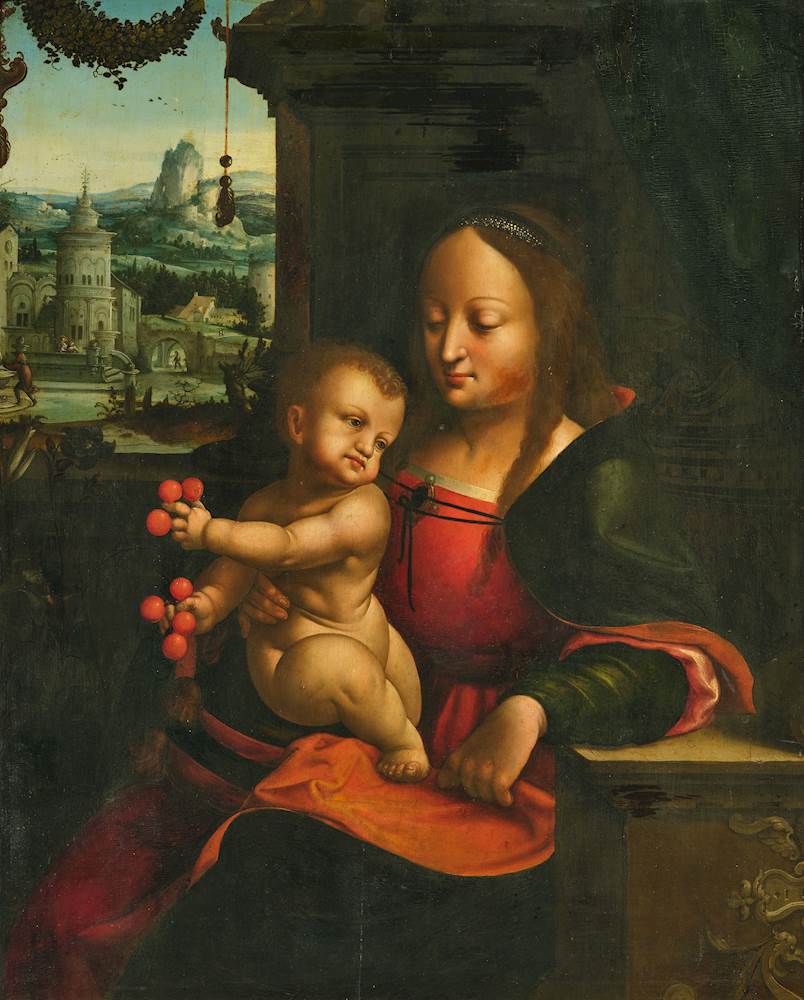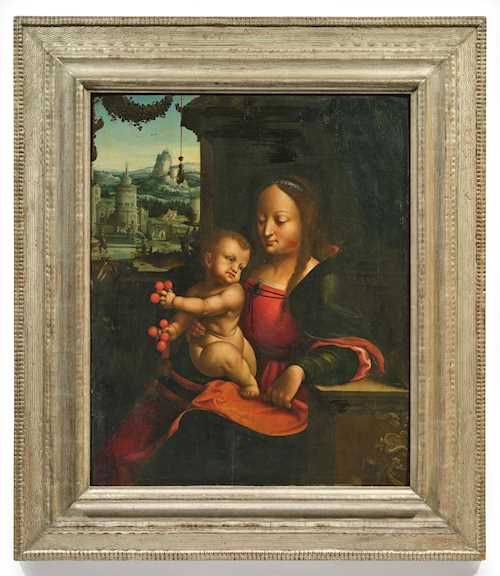Lot 3003 - A210 Tableaux de Maîtres Anciens - vendredi, 20. septembre 2024, 14h00
Circle of JOOS VAN CLEVE
(circa 1485 Antwerp circa 1540)
Madonna and child.
Oil on panel.
Remains of a date lower right on the plinth: 152...
75 × 61 cm.
Provenance:
Private collection, Switzerland.
The Madonna of the Cherries, along with the depiction of Jesus and John the Baptist as boys embracing, was probably one of the most popular compositions in Antwerp in the second half of the 1520s, especially in the oeuvre of Joos van Cleve and his studio. It is based on a lost prototype by Leonardo da Vinci (1492–1519), which was created in Milan around 1508 and widely used in numerous copies from the Italian master's workshop. The version by Giampetrino (active 1495–1549), now in a private collection, was probably also in Antwerp at the time and served as a direct model for the version offered here (ill. 1, in: Joos van Cleve – Leonardo of the North, ed. by Peter van den Brink, exhib. cat. Suermondt-Ludwig-Museum Aachen, Aachen 2011, p. 116, ill. 89). As Micha Leeflang explains, there was probably a cartoon in Cleve's workshop which allowed this popular motif to be reproduced (ibid. 149). Antwerp was the birthplace of serial production at the time, which made it possible to satisfy the great demand for works of art inspired by Italian styles (see Peter van den Brink: ‘The Art of Copying: Copying and Serial Production of Paintings in the Low Countries in the Sixteenth and Seventeenth Centuries’, in: Brueghel Enterprises, ed. by Peter van den Brink, exhib. cat. Bonnefantenmuseum, Maastricht and Museés royaux des Beaux-Arts de Belgique, Brussels 2001 pp. 20–36). Dr John Hand suspects that our work originated in the workshop of Joos van Cleves, for which we are grateful. Dr Micha Leeflang, to whom we are also grateful for her opinion, recognises in our version an accomplished painter in the master's circle in Antwerp. The localisation to Antwerp is also explained by the characteristic architecture on the left in the background. With the help of infrared reflectography, one can also recognise underdrawings that prove the artistically individual realisation of the composition (ill. 2).
In his depictions, Joos van Cleve adopts da Vinci-esque characteristics such as sfumato, the lighting and the shapes of the curved, round faces and combines them with Italianised formal elements according to his own ideas. This independent interpretation can also be recognised in this version in the garland of foliage, the background landscape visible through the window section, and the tendril-like ornamentation in the architecture.
CHF 8 000 / 10 000 | (€ 8 250 / 10 310)
Vendu pour CHF 10 000 (frais inclus)
Aucune responsabilité n'est prise quant à l´exactitude de ces informations.



